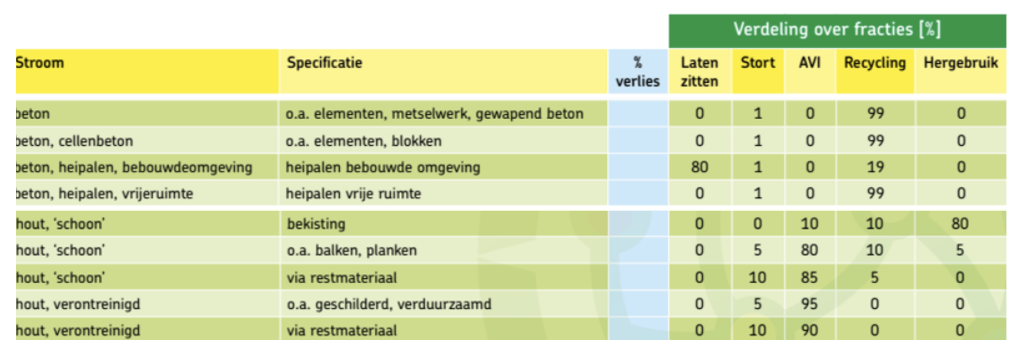The Dutch government has committed itself to reducing greenhouse gas emissions by 95% by the year 2050 in comparison with 1990 emissions. The target is to reduce emissions to 49% by 2030 [1]. In addition, the climate agreement states that the Dutch government wants to be fully circular by 2050. This goal can be achieved through reuse, recycling and the efficient use of raw materials from sustainable sources. The environmental impact of materials is determined using a life cycle assessment (LCA).
Emissions in the construction sector
Construction is a resource-intensive sector that generates many emissions. The production of concrete, for example, consumes large amounts of water: one trillion litres of drinking water yearly worldwide. Also, large amounts of CO2 are released, 6-8% of global CO2 emissions. In this sector, therefore, there is still much to be gained in terms of circularity, nitrogen emissions, CO2 emissions, freshwater use, and other raw materials such as limestone.
The use of bio-based materials, such as wood, mycelium, or hemp, offers an alternative without these harmful effects. The wood construction industry is dissatisfied with the current "Bepalingsmethode Milieuprestatie Bouwwerken" [2]. The assessment method is the standard for determining and expressing the environmental performance of buildings based on a life cycle assessment (LCA). Wood and other bio-based materials would be disadvantaged compared to conventional materials such as concrete.

Carbon storage in wood
Firstly, biogenic carbon (carbon fixed in organic material such as trees) is currently included in an LCA according to the -1/+1 method. This means that the carbon absorbed by a tree during growth causes negative CO2 emissions or absorption. However, the same quantity of carbon is re-released at the end-of-life phase, for example, through combustion. This -1/+1 method creates insight into the uptake and emission of carbon, but does not influence the environmental performance.
Although the carbon is indeed released eventually, in the current climate, it is beneficial to create carbon storage as one of the means to achieve the 2050 climate goals. Many other methods can be found that incorporate carbon storage into environmental performance, for example, in the report by Climate Cleanup [3]. The most appropriate method seems to be to include long-term biogenic carbon storage (>100 years) as permanent storage, integrated into the environmental performance. The advantage of this is that the positive impact of carbon storage is immediately visible.
However, some things have to happen before it is possible to apply this. For example, the European standard (EN 15804) and the Assessment Method must be amended because counting biogenic carbon storage is not permitted. Furthermore, it must be possible to demonstrate that wood products can be used for more than 100 years. This should not be a problem. Think for example, of wooden beams in centuries-old canal houses.
Lifespan of wood
A second criticism is that the lifespan of wood is underestimated or insufficiently explored. There is indeed less information available for wood in the National Environmental Database, but the life span predictions are about the same as for concrete. To make more information available, more studies on wood products will be needed, and more producers will have to facilitate a product map in the NMD.

Incineration or recycling of wood
Finally, the end-of-life assumptions for wood and concrete are questionable. The percentage of recycling is underestimated for wood. These percentages apply in modules C and D of a construction LCA. At the moment, the distribution according to the flat-rate values of the National Environmental Database for wood and concrete is as follows:
Although formwork is indeed largely recycled, the recycling rate for other types of wood is very low. In reality, 32% of A- and B-wood (clean wood) is currently recycled. A large proportion is made into chipboard. A report by Gemax identifies the main areas for improvement in wood recycling. Buildings should be demolished more carefully, the share of recycled wood in chipboard could be increased, we could use new alternatives such as bobbins in pallets and ECOR wood panels.
Also, a process has recently been developed to make bioplastic from wood in an environmentally friendly way. Moreover, other end-of-life scenarios are conceivable than incineration, such as composting, where carbon is stored for a long time and gradually released into the carbon cycle. This alternative prolongs carbon storage for up to 100-1000 years. It is currently assumed that biogenic carbon is released within 100 years in an LCA. Moreover, it is cheap compared to the shadow costs of combustion. In the case of concrete, 99% recycling is assumed, while the majority (95%) is downcycled into, for example, road aggregate. Innovations make high-performance concrete recycling possible, but unfortunately, these are not yet widely used. If downcycling of concrete is counted as recycling, downcycling of wood to chipboard should also be included in the lump sum values. This would have a huge impact on environmental performance, as the production impact may be cancelled out if the product is recycled.
The Assessment Method will have to be adapted to these points to bring the circular aspects of wood to the fore. In this way, timber construction will be stimulated and can contribute to a circular economy.
Sources & Links
- Ministerie van Infrastructuur en Waterstaat. (z.d.). Klimaatbeleid. Klimaatverandering | Rijksoverheid.nl. https://www.rijksoverheid.nl/onderwerpen/klimaatverandering/klimaatbeleid#:%7E:text=Nationale%20doelen%20voor%20terugdringen%20van%20broeikasgassen&text=49%25%20minder%20CO2%2Duitstoot,die%20partijen%20onderling%20hebben%20gemaakt.
- Stichting Nationale Milieudatabase. (z.d.). Bepalingsmethode. Nationale Milieudatabase. https://milieudatabase.nl/milieuprestatie/bepalingsmethode/
- ANS Bank, Climate Cleanup, & Gideon. (2021). Construction Stored Carbon. https://climatecleanup.org/wp-content/uploads/2022/01/Construction-Stored-Carbon-V8-11-2021-5.pdf






